Have you found a sore in your child's mouth and do not know what to do? In this article, you will learn what kinds of stomatitis are, what they differ, their symptoms and the causes of their occurrence. And also with what medicines and folk remedies can be treated stomatitis in the home.
Contents
- What are the types of stomatitis in a child?
- Herpetic stomatitis in children
- Candidiasis or fungal stomatitis( thrush)
- Aphrotic stomatitis in children
- Angular stomatitis in children
- Bacterial stomatitis in children
- Stomatitis in children: symptoms
- Stomatitis in children before the year
- How to treat stomatitis in children before the year?
- How to treat stomatitis in a child 1 and 2 years old?
- How to treat stomatitis in children in the mouth? Drugs and medications for stomatitis for children
- Folk remedies for stomatitis in children. Treatment of stomatitis at home
- Treatment of mouth
- Herbal infusions
- Use of products
- Natural oils
- VIDEO: Children's stomatitis. How to recognize and how to treat - The school of Dr. Komarovsky
If the child is crying, he has a bad dream and appetite, maybe there is a temperature and he complains of pain in his mouth, parents need to suspect the disease with stomatitis. Look at the baby in the mouth, most likely you will find there sores or redness. Do not treat stomatitis yourself, tk.for effective treatment you need to find out the cause of the disease, it can be caused by viruses, fungi or bacteria.
 Stomatitis in Toddlers
Stomatitis in Toddlers What are the types of stomatitis in a child?
There are several main types of stomatitis that often occur in children:
- candidal stomatitis, most often occurs in children under 3 years old
- aphthous stomatitis, this allergic disease often occurs in schoolchildren
- herpetic( viral) stomatitis, usually seen in children from one yearup to three
- angular stomatitis, simple - "jam"
- bacterial stomatitis, occurs when injuring the oral mucosa and neglecting hygiene( unwashed products, hands), often occurs in young children, Everyone pulls into the mouth
Stomatitis often occurs in babies, becausetheir delicate oral mucosa is easily traumatized, and immunity does not yet work properly and simply does not cope with all infections. In the saliva of small children, there is not the necessary amount of enzymes that act as antiseptics.
 Stomatitis in infants
Stomatitis in infants Stomatitis of any kind can occur in various forms, both mild and severe, can be chronic or have relapses.
Herpetic stomatitis in children
This form most often occurs in children and adults. This is due to the fact that almost all people are infected with the Herpes virus, but whether the adult or the child will be sick depends on the immunity.
This virus is dangerous because it is always present in the body, it can be latent or become a chronic disease with persistent relapses.
If the child's organism has encountered this virus, it will actively fight, so when herpetic stomatitis the child has a high fever and there are signs of intoxication of the body.
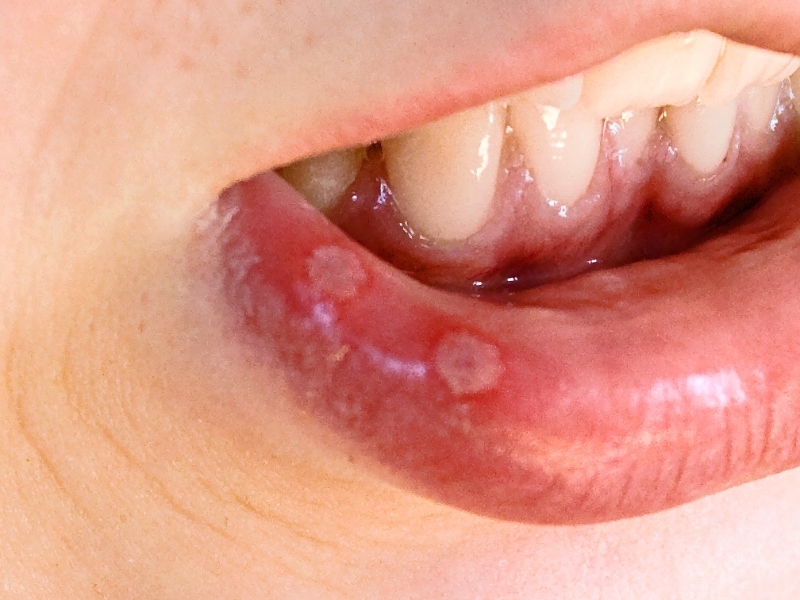 Herpetic stomatitis
Herpetic stomatitis Features of herpetic stomatitis:
- on the mucosa at the beginning of the disease appears redness, then there are sights, when there is a rupture of the bubbles, there are ulcers or cracks
after the healing of ulcers, on the mucosa can consider the marble pattern
the child becomes irritable, does not want to eat, tk.ulcers cause burning and itch. - this kind of stomatitis can be confused with ARVI;the symptoms are the same: the temperature first increases to 38 ° C, the lymph nodes increase, then after the appearance of ulcers the temperature rises to 39 ° C and is often poorly confused by drugs, nausea and vomiting may occur, the head may become ill and the chill
- appear during the acute period of the diseasecount up to 20 ulcers, which can be not only in the mouth, but also on the nose and lips, the gingiva is inflamed and dry mouth is felt
- if the disease is easily transferred, ulcers usually up to 6 pieces, the temperature does not rise above 38 ° C, easilygets lost untilquickly, the child recovers
Candidiasis or fungal stomatitis( thrush)
Candidiasis usually appears in infants in the form of thrush, which is easy to recognize by the characteristic white coating on the tongue and even the lips.
 Kididosis stomatitis
Kididosis stomatitis Features of fungal stomatitis:
- usually the disease passes without raising the body temperature
- sores can be with white or gray coating, reminiscent of cottage cheese
- , the wounds are very painful, I can burn, itch, there is a feeling of dryness, so the child is naughty, he has restless sleepand poor appetite
- sores often appear on the gum, the inner surface of the lips and cheeks, and also in the language of
- lesions have a white coating that passes into a homogeneous film of
Aphthous Stomatat have children
There is an opinion that canker sores occur because of improper operation of the digestive system, other doctors believe that it occurs due to allergic reactions, which result in injury to the mucous membrane. Because of the unclear reasons for the occurrence of this kind of stomatitis, it is rather difficult to treat it.
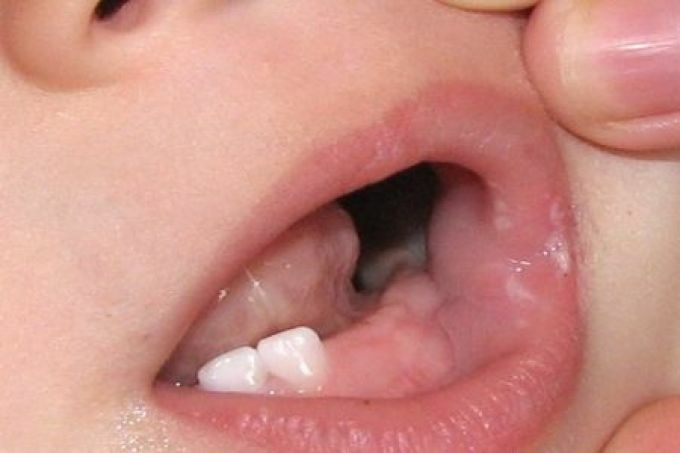 Aphthous stomatitis
Aphthous stomatitis Features of aphthous stomatitis:
- ulcers are similar to mucosal lesions as in herpetic stomatitis, redness, itching, temperature of
- can appear, then aphthae appear instead of vesicles - white sores around which there is redness, and they are very sore, formround and flat edges
- further in the jaundice appears hazy film
- if the infection has been re-entered after the ulcer has broken, the course of the disease worsens, the body temperature may increasein a child
Angular stomatitis in children
Zaeda, wet cracks in the corners of the mouth, most often appear due to a lack of a child's iron body. Also, angular stomatitis causes streptococci or yeast-like fungi of the genus Candida. These fungi can be on the mucous surface of the child and cause the disease with a decrease in body immunity and inadequate intake of vitamins.
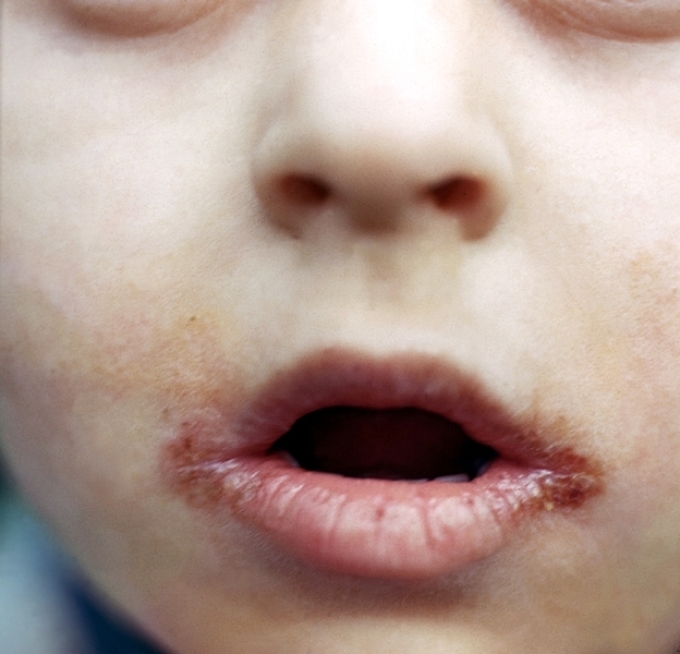 Angular stomatitis
Angular stomatitis Features of angular stomatitis:
- cracks in the corners of the mouth, depending on the causes of the occurrence, can be without crust, lacquer-red and with a grayish coating( fungus) and with purulent crust, if it is ruptured, the wound will bleed( streptococcal)
- fungal stomatitis often passes into a chronic disease
- angular stomatitis can occur due to an incorrect bite
- poor hygiene also provokes this disease, as does the presence of caries in the mouth
This type of stomaita sometimes very concerned about the child, becausein the absence of treatment or improper treatment, the child's condition worsens, it becomes painful to open your mouth to say something or eat.
Bacterial stomatitis in children
 Bacterial stomatitis
Bacterial stomatitis This kind of stomatitis is caused by bacteria that live in the human body. With a decrease in immunity due to the presence of dental diseases, as well as tonsils and nasopharynx, the bacteria become active. However, stomatitis does not occur in this case, if the mucous membranes are not injured, but with the slightest damage, the bacteria immediately get there.
Features of bacterial stomatitis:
- disease begins with pain during eating, especially acidic and acute products
- then reddens the mucous surface of the mouth, ulcers appear, they cause burning sensation, itching, swells mucous, there is an unpleasant smell
- it becomes painful to brush your teeth,to.gingiva is swollen, the surface of their friable, bleeds
- infection can go further in the nasopharynx, in such cases, the child also has angina
Stomatitis in children: symptoms
The main symptom of the presence of stomatitis in the child are sores in the mouth, most often they are located behind the bottomlips and see them you can, bending it and looking inward.
Ulcers are different in structure, from fairly well-marked pimples and redness, to a slight irritation. Therefore, parents need to be vigilant and carefully examine the entire oral cavity - the mucosa normally has a uniform pink color and a smooth structure.
A minor symptom in children is a change in their behavior: they begin to be harmful, capricious, poorly eat and sleep, becauseThe sores are quite painful and bother the kids.
Another common symptom of stomatitis is an increase in lymph nodes that are located under the jaw. In addition, they are enlarged, they are also painful.
Also, if the stomatitis herpetic , the child has the following symptoms:
- sores occur at one time in different places, and they are almost the same size
- a second wave of the disease is possible: first there are ulcers and the temperature rises, then everything passes, but after a fewdays begins anew
from the mouth appears unpleasant odor - slightly swollen gum
If stomatitis aphthous , children have the following symptoms:
- a couple of days before the main symptoms, appearingThis symptom is called "geographic language"
- often in the language of the child there is a white coating
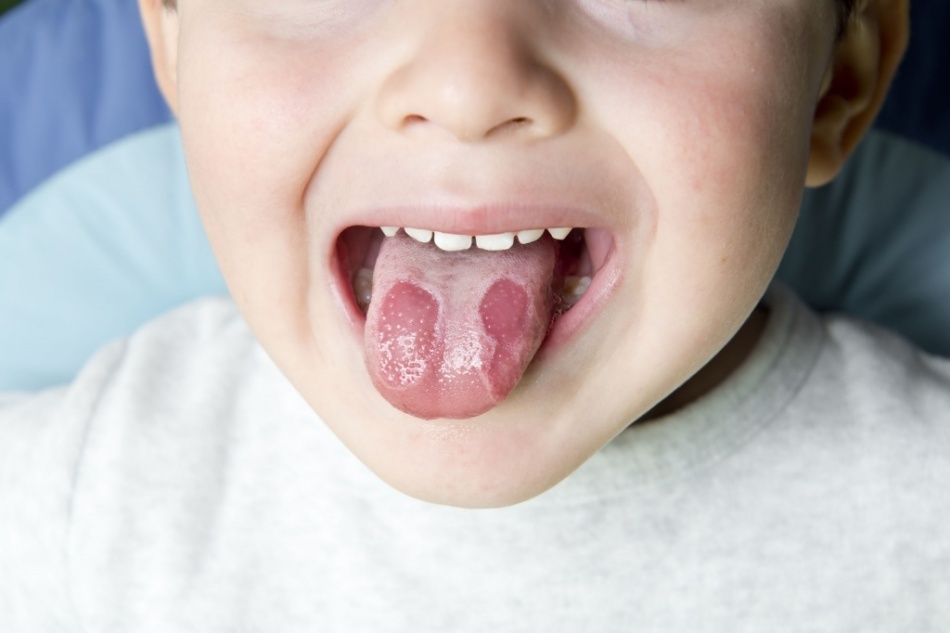 "Geographical language"
"Geographical language" Stomatitis in children up to the year
Children's body is not yet strong enough to repel attacks of various viruses,bacteria and fungi, so stomatitis often occurs in toddlers. Children under one year old who are breastfed receive some immunity from their mother's milk, but this is not always enough to not get sick.
Breastfeeding most often occurs fungal stomatitis, which is not difficult to recognize. White coating on the lips, the sky, the inner surface of the lips and cheeks, in the language - a business card of stomatitis caused by a fungus. Also, quite often, babies get the virus form of this disease.
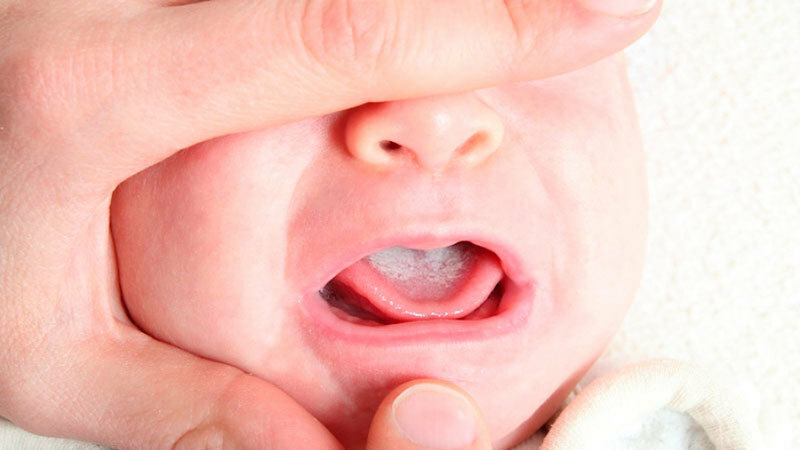 Stomatitis in infants
Stomatitis in infants It is important for children from birth to monitor personal hygiene and oral hygiene, temper the body of the child and protect it from infections.
How to treat stomatitis in children under one year old?
- For a start, you need to determine a viral stomatitis or fungal, becausethe treatment will be different
- Keep clean: wash the toys with which the child is playing and licks, it is better to certainly burn them with boiling water, as well as baby bottles and nipples.
- . Let's taste neutral, not sour, not salty, without spices, so that it does notirritated the sores even more
- If stomatitis is candidal( thrush), temporarily stop giving the baby dairy products
- After each meal, you need to treat the sores with an antiseptic, for example, soda solution or a solution of furatsilina
- Doveas prescribed by the doctor. Often doctors prescribe Holisal gel, it also contains an anesthetic that will remove the pain of
- . In acute forms of stomatitis, it may be necessary to undergo disinfecting physiotherapy
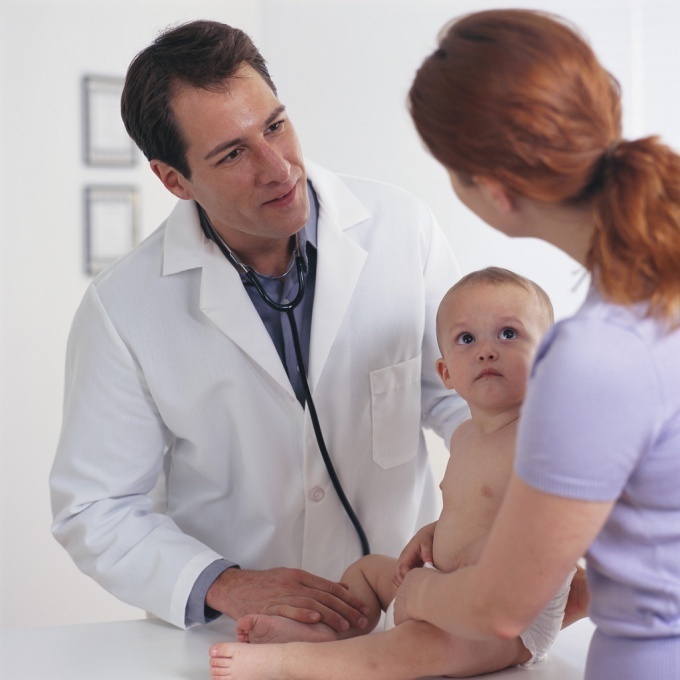 Treatment of stomatitis in infants
Treatment of stomatitis in infants Parents should understand the state of the crumbs and treat their caprices with patience. Their condition is further complicated by the fact that young children are looking for comfort in sucking, and often all diseases are carried out by the mother under the breast, but in this case, sucking will cause pain. Therefore, you need to start treatment as soon as possible.
How to treat stomatitis in a child 1 and 2 years old?
Children at this age are small researchers and very active, so often there is viral stomatitis.
Viral stomatitis is dangerous because it spreads rapidly. In no case do not lead the child to the playground or nursery, at this age children often exchange drooling through the hands and toys, so you risk infecting all the children with whom your baby will be in contact.
 Stomatitis in a child up to 2 years old
Stomatitis in a child up to 2 years old Take all preventive measures so that you do not become infected with viral stomatitis:
- often do a wet cleaning in the house, wash toys
- make sure that the baby is well and often washed his hands
- sterilize bottles, nipples and otherpersonal things of the child
- personal belongings of the child should only be his, do not lick his spoon, and do not try the tea from his cup - you can be a carrier of
- do not walk with children who are now bleating stomatitis
- strengthen baby immunity
- ,so that the child does not freeze
How to treat stomatitis in children in the mouth? Drugs and medications for stomatitis for children
With herpetic stomatitis the basis of treatment will be a drug that reduces the activity of the herpes virus, for example, Acyclovir or Viferon. These drugs have antiviral properties, but their use is advisable in the first 2-3 days of onset of the disease, before the bubbles burst.
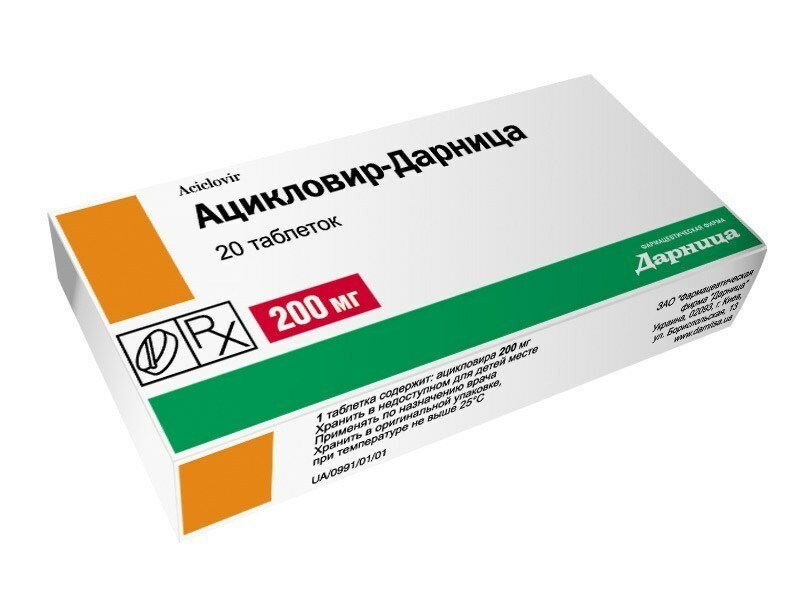 Acyclovir from stomatitis
Acyclovir from stomatitis For rinsing it is necessary to use solutions that are active against the Herpes virus, for example, Miramistin. You need to rinse 3-4 times a day. However, small children do not know how to rinse your mouth, so soak a cotton swab in the solution and wipe the mucous surfaces of the child's mouth with it.
 Treatment of the mouth of the baby
Treatment of the mouth of the baby Rinse the mouth of the baby can be as follows: take the medicine in a small pear, tilt the baby upside down so that it does not choke, and inject into the mouth solution.
With aphthous stomatitis, the duration of the disease should not exceed two weeks, otherwise consult a doctor immediately. Since there are several reasons for the occurrence of aphthous stomatitis, the treatment is also different.
The first thing to do is to exclude foods that are allergic to, and foods that can exacerbate the disease( sour, sharp, rough food).
Antihistamines are prescribed, such as Suprastin or Claritin. The oral cavity is processed by Miramistin in the initial and middle period of the disease, as well as the pointwise treatment with aphasis gel Halysal.
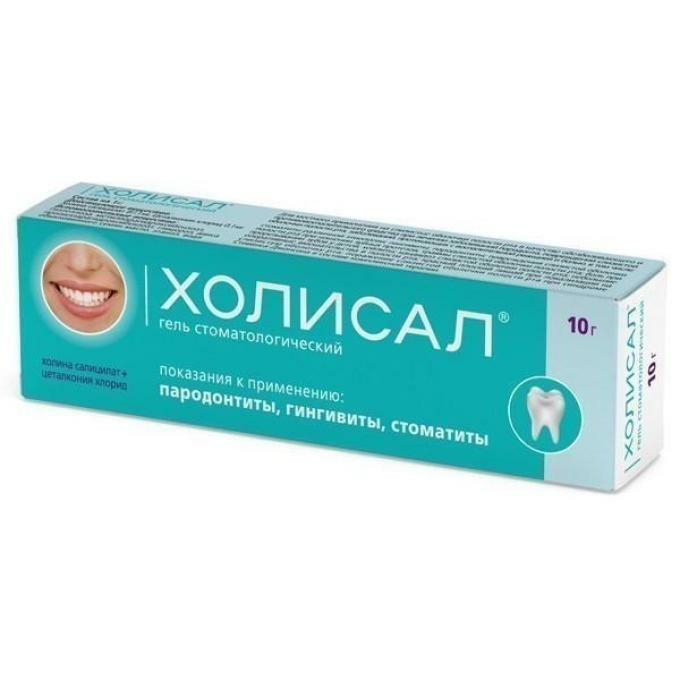 Gel Holysal from stomatitis
Gel Holysal from stomatitis At the end of treatment, epithelial agents are used to treat mucosal damage. Also often used physiotherapy with ultraviolet rays.
With angular stomatitis the doctor will prescribe the iron preparations for the child.
In no case do you hope to fill iron deficiency with products, they can only maintain the required level, but if it is not enough, you must definitely take iron preparations, and do not ignore the doctor's prescription.
Folk remedies for stomatitis in children. Treatment of stomatitis at home
Quite often, treatment of stomatitis in the home by folk remedies gives positive results.
Treatment of the mouth
To wipe the mucous surface of the baby's mouth, you can prepare a soda solution, for this, dilute 1 teaspoon baking soda in a glass of boiled water. Wrap the bandage on your finger and, dipping into the soda solution, lubricate the damaged areas. Marl at the same time will clean the plaque, and soda will disinfect wounds.
 Rinse mouth with stomatitis
Rinse mouth with stomatitis In the same way, treat the damaged areas with ordinary greens, it also works well for stomatitis.
Herbal infusions
A good antiseptic is the infusion of chamomile. Prepare it, fill 1 teaspoon of dried flowers with a glass of boiling water, leave to boil and strain when it cools. Rinse the broth with the mouth several times a day.
Well-brewed brewed green tea, but for kids it is better to make a decoction of marigold.
For children, you can make a pink syrup: wash the petals of a tea rose with sugar in a ratio of 1: 2 and leave it overnight, then heat it in a water bath until the sugar dissolves completely. This syrup needs to be processed by the mouth after eating, the child will be happy to give you this delicious procedure.
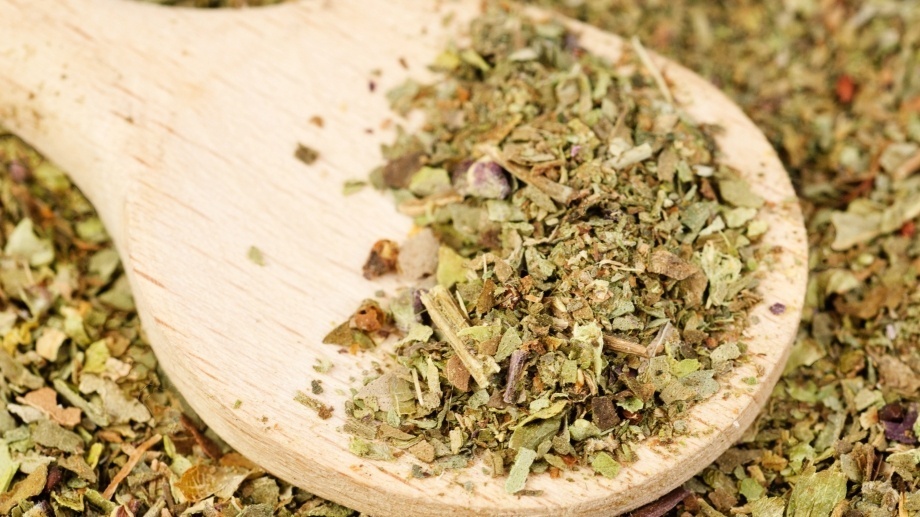 Herbal treatment with stomatitis
Herbal treatment with stomatitis You can also bark oak bark, yarrow, burdock, sage or a mixture of these herbs. Rinse your mouth with broths after each meal.
At home, you can still use scarlet. Give the child a well-washed aloe leaf and ask him to chew, if the baby does not want, you can grind it and attach the resulting gruel to the affected area. That the child is not harmful, it is possible to add one spoon of honey.
Use of products
If the child does not have allergies, when the sores have just begun to appear, smear them with honey.
Another popular tool is raw potatoes. Attach the gruel from the grated potatoes to the affected areas and keep about 5 minutes at least 2 times a day, this treatment is spent about a week.
 Treatment of raw potatoes with stomatitis
Treatment of raw potatoes with stomatitis If there is no allergy to egg white, you can use it to eliminate symptoms of stomatitis. To do this, mix the protein of one egg with a glass of boiled water and caress the mouth with this mixture about 4 times a day. At the same time, the wound is wrapped around, so that they heal faster.
Natural oils
To quickly heal the wounds, you can use various oils, such as peach, flax or rose hips. After processing the mouth with antiseptics, oil them with oil. Such treatment should be carried out at least 4 times a day, and do not skip the procedures, regularity is important here.
 Treatment of ulcers with oil for stomatitis
Treatment of ulcers with oil for stomatitis It should be noted that it is not necessary to treat a child of stomatitis alone. Be sure to consult with your doctor, whether such treatment will be effective in this particular case and will it help to cure your child of the kind of stomatitis with which he fell ill.
